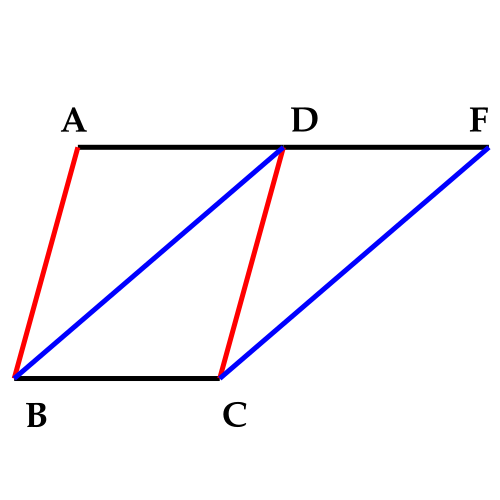Parallelogram
정의
사각형 중, 두 쌍의 대변이 각각 평행한 사각형. 사다리꼴의 세부 분류이며, 사다리꼴과는 달리 학교에서 자세히 다루게 되는 도형이다.
필요충분조건
일단 평행사변형의 정의는 따로 있지만, 그 정의와 필요충분조건인 다른 조건들이 꽤 많다. 아래는 그 목록.
- 두 쌍의 대변의 길이가 같다.
- 두 쌍의 대각의 크기가 같다.
- 두 대각선이 서로를 이등분한다.
- 한 쌍의 대변이 평행하고, 그 길이가 같다.
증명
1. [math]\displaystyle{ \triangle{ABC}\cong\triangle{CDA} }[/math](SSS 합동)임을 쉽게 알 수 있다. 따라서 [math]\displaystyle{ \angle{CAB}=\angle{ACD} }[/math]이고, 이는 곧 [math]\displaystyle{ \overline{AB}\parallel\overline{CD} }[/math]를 의미한다 (엇각). 마찬가지로 [math]\displaystyle{ \triangle{ADB}\cong\triangle{CBD} }[/math](SSS 합동)이고, [math]\displaystyle{ \angle{ADB}=\angle{CBD} }[/math]이므로 [math]\displaystyle{ \overline{AD}\parallel\overline{BC} }[/math]이다 (엇각).
2. [math]\displaystyle{ \angle{A}=\angle{C}=\alpha,\,\angle{B}=\angle{D}=\beta }[/math]라 하자. 사각형의 내각의 합은 360도 이므로, [math]\displaystyle{ 2\alpha+2\beta=360^\circ,\,\alpha+\beta=180^\circ }[/math]이다. 이를 이용해 엇각을 보일 수 있고, 따라서 [math]\displaystyle{ \overline{AB}\parallel\overline{CD},\,\overline{AD}\parallel\overline{BC} }[/math]이다.
3. [math]\displaystyle{ \triangle{AEB}\cong\triangle{CED} }[/math](SAS 합동)이고, 따라서 [math]\displaystyle{ \angle{EAB}=\angle{ECD} }[/math]이므로 [math]\displaystyle{ \overline{AB}\parallel\overline{CD} }[/math]이다 (엇각). 마찬가지로 [math]\displaystyle{ \triangle{AED}\cong\triangle{CEB} }[/math]이고, 따라서 [math]\displaystyle{ \angle{EAD}=\angle{ECB} }[/math]이므로 [math]\displaystyle{ \overline{AD}\parallel\overline{BC} }[/math]이다 (엇각).
4. [math]\displaystyle{ \overline{AB}\parallel\overline{CD} }[/math]이므로 [math]\displaystyle{ \angle{EAB}=\angle{ECD},\,\angle{EBA}=\angle{EDC} }[/math]이다 (엇각). 따라서 [math]\displaystyle{ \triangle{EAB}\cong\triangle{ECD} }[/math](ASA 합동)이고, 3번 조건에 의해 증명하고자 하는 바가 증명되었다.
역의 증명
1. [math]\displaystyle{ \overline{AB}\parallel\overline{CD} }[/math]이므로 [math]\displaystyle{ \angle{CAB}=\angle{ACD} }[/math]. 또한, [math]\displaystyle{ \overline{AD}\parallel\overline{BC} }[/math]이므로 [math]\displaystyle{ \angle{ACB}\angle{CAD} }[/math]. 그리고 [math]\displaystyle{ \overline{AC} }[/math]공통. 따라서 [math]\displaystyle{ \triangle{ABC}\cong\triangle{CDA} }[/math](ASA 합동). 따라서 [math]\displaystyle{ \overline{AB}=\overline{CD},\,\overline{AD}=\overline{BC} }[/math].
2. [math]\displaystyle{ \overline{AB}\parallel\overline{CD} }[/math]이므로 [math]\displaystyle{ \angle{CAB}=\angle{ACD} }[/math]. [math]\displaystyle{ \overline{AD}\parallel\overline{BC} }[/math]이므로 [math]\displaystyle{ \angle{DAC}=\angle{BCA} }[/math]. 따라서 [math]\displaystyle{ \angle A=\angle C }[/math]. 마찬가지 방법으로 [math]\displaystyle{ \angle B=\angle D }[/math]를 증명할 수 있다.
3. 1번에 의해 [math]\displaystyle{ \overline{AB}=\overline{CD} }[/math]. 또한, [math]\displaystyle{ \overline{AB}\parallel\overline{CD} }[/math]이므로 [math]\displaystyle{ \angle{EAB}=\angle{ECD},\,\angle{EBA}=\angle{EDC} }[/math]. 따라서 [math]\displaystyle{ \triangle{EAB}\cong\triangle{ECD} }[/math] (ASA 합동). 그러므로 [math]\displaystyle{ \overline{EA}=\overline{EC},\,\overline{EB}=\overline{ED} }[/math]
4. 1번에 의해 증명이 완료되었다.
넓이
사다리꼴의 넓이는 직사각형과 마찬가지로 밑변[math]\displaystyle{ \times }[/math]높이인데, 이유는 간단하다. 튀어나온 부분을 툭 짤라서 반대편에 붙이면 직사각형이 되기 때문. 혹은 [math]\displaystyle{ \overline{AB}=a,\,\overline{BC}=b,\,\angle{A}=\theta }[/math]라 하면 삼각함수를 이용해 [math]\displaystyle{ 2\times\frac{1}{2}\times ab\sin\theta=ab\sin\theta }[/math]로 구할 수도 있다. 대각선의 길이를 이용할 수도 있는데, 두 대각선의 길이를 각각 [math]\displaystyle{ p,q }[/math]라 하고 교각을 [math]\displaystyle{ \theta }[/math]라 하면 [math]\displaystyle{ \frac{1}{2}pq\sin\theta }[/math]가 넓이가 된다. 이유는 두 대각선을 변으로 하는 평행사변형을 만들었을 때, 원 사각형의 넓이의 두배가 되기 때문.
융용

|
| 유클리드 기하학 원론 제1권 법칙35 |